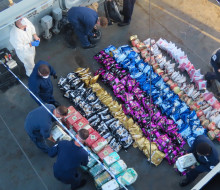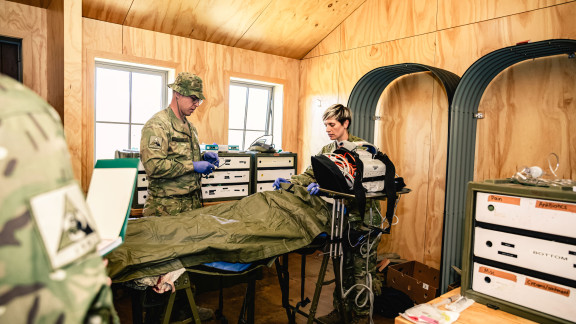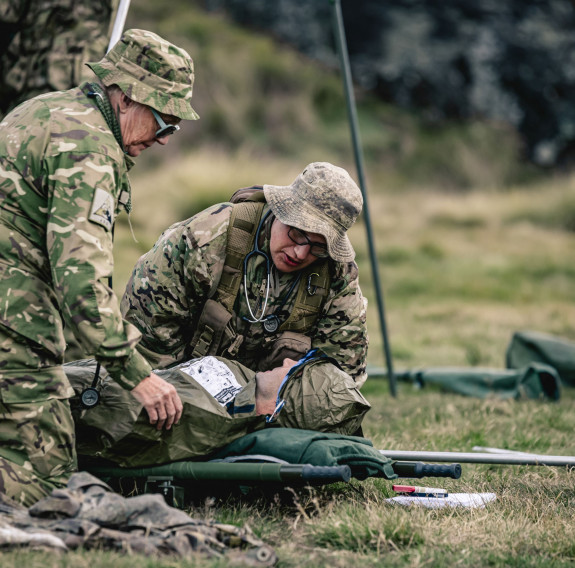
New Zealand-led task force makes $NZ332-million drug bust in the Middle East
14 March 2025
Unfortunately you are viewing this website on an outdated browser which does not support the necessary features for us to provide an adequate experience. Please switch to a modern browser such as latest version of Google Chrome, Mozilla Firefox, Apple Safari or Microsoft Edge.
Ngā mihi nui
The scenario – the Alpine Fault, New Zealand’s largest fault line running 600km along the South Island, has just ruptured.
Found lying in a creek bed in Central Otago’s Pisa Conservation Area, hypothermic and barely conscious, a man is carried to a nearby New Zealand Army medical detachment for treatment. Two medical specialists administer initial treatment, four prepare the 11m x 11m tent where the man will be stabilised prior to emergency services arriving.
While this may just be a training scenario for 27 New Zealand Army Regular and Reserve Force doctors, nurses and medics from the Deployable Health Unit, scientists predict a 75 per cent chance of a magnitude-8.0 or higher earthquake along the fault line, one of the world’s major geographical features, within fifty years.
The training, at the Snowfarm Nordic Ski Area was specifically selected for its infrastructure and remote environment. The majority of personnel attending the weekend were part-time Reserve Force medics many of whom work or study within the medical field bringing a diversity of experience and skills.

Medical alpine training | New Zealand Army
Lieutenant Colonel Glen Whitton, Commanding Officer of the Deployable Health Organisation, says Alpine training gives a unique opportunity to adapt to training at altitude and in isolated areas.
“Medical training is normally focused on combat scenarios. However we assist in humanitarian and disaster relief in New Zealand and the Pacific. The likelihood is we will be called on to respond potentially to humanitarian and disaster emergencies,” he said.
The training is adaptable to any deployment – from assisting Pacific nations to further abroad.
The teams consisting of a commander, doctor, nurse and two medics practiced two different ways to respond. One was a mobile detachment where the team travels to be closer to casualties in a New Zealand Army Pinzgauer. A portable 11m x 11m tent is erected where medical treatment is administered under basic conditions. The other detachment occupies existing hard standing buildings and in this case operated from a remote alpine hut.
“The medical detachment is designed to triage and stabilize a patient on or near the location of their injury giving them a higher rate of survival. Once stabilized, ideally emergency services would extract them from the location to the nearest hospital,” said senior medic and training facilitator, Sergeant Danny Freestone.
“The detachment is controlled by a commander in headquarters. The team may be required to move at short notice or they may stay on location and have patients brought from the frontline to receive treatment.”

NZ Army medics adapt to different environments during a training exercise in the Pisa Conservation Area

NZ Army medics adapt to different environments during a training exercise in the Pisa Conservation Area

NZ Army medics adapt to different environments during a training exercise in the Pisa Conservation Area
Command Warrant Officer of the Deployable Health Organisation, Warrant Officer Class One Shelley Eriksson acknowledges the environment is an important area needing to be targeted in training.
“Training at the Snowfarm has given us an opportunity to work outside of a combat environment in a remote location allowing us to highlight areas we need to focus on.
“Having to work with a team you may not have worked with previously builds resilience, communication skills and creates camaraderie within the wider medical network. There’s a high possibility some of the team could be responding to humanitarian assistance and disaster relief in New Zealand, the Pacific or deploying together overseas,” she said.